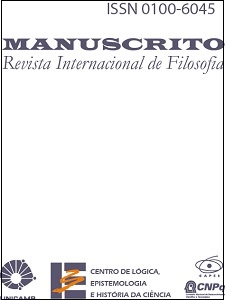Abstract
It is argued that there is a plausible way to read Kant as consistently repudiating a two-worlds picture and upholding a de-reistic view whereby the transcendental object or thing in itself indicates only a pure concept of the understanding whose role is to govern the synthesis of any unified manifold. This reading of Kant liberates him from the well-known textual and philosophical difficulties of the two-worlds view. Furthermore, I argue that this interpretation leads to a strong idealist position as opposed to the double-aspect view of Allison and Prauss. This idealist position was basically adopted by Fichte in his Introductions to the Science of Knowledge of 1797, wherein the debunking of the thing in itself was a crucial step in his ultimate argument for the unity of theoretical and practical reason.
References
ADICKES, E. (1924). Kant und das Ding an Sich. (Berlin, Pan, 1924).
ALLISON, H. (1983). Kant's Transcendental Idealism (New Haven and London, Yale University Press).
————. (1968). “Kant's Concept of the Transcendental Object”, in Kant-Studien, vol.59, pp.165-186. BIRD, G. (1962). Kant's Theory of Knowledge (London, Routledge and Kegan Paul).
COFFA, A. (1991). The Semantic Tradition from Kant to Carnap: To the Vienna Station (Cambridge, Cambridge University Press).
FICHTE, J.S. (1982). Science of Knowledge, ed. Peter Heath and John Lachs (Cambridge, Cambridge University Press).
HICKEY, L. (1994). “Kant's View of the Transcendental Imagination in the 1st Critique”, Conference, Fall.
JACOBI, F.H. (1812). Werke, hrsg. Von F.Roth und F.Koppen, Leipzig, vol II, p.304-5.
KANT, I. (1965). Critique of Pure Reason, transl. Norman Kemp Smith, (London, Macmillan).
KEMP SMITH, N. (1962). A Commentary to Kant's “Critique of Pure Reason” (New York, Humanities Press).
KÖRNER, S. (1985). “On Kant's Theory of Concepts”, in Sixth International Kant Congress (Penn State), pp.55-70.
NEUHOUSER, F. (1992). Fichte’s Theory of Subjectivity (Cambridge, Cambridge University Press).
PATON, H.J. (1936). Kant's Metaphysic of Experience (New York, Macmillan).
PRAUSS, G. (1971). Erscheinung bei Kant (Berlin, de Gruyter).
————. (1974). Kant und das Problem der Dinge an Sich (Bonn, Bouvier Verlag Herbert Grundmann).
RESCHER, N. (1974). “Noumenal Causality”, in Kant's Theory of Knowledge ed. Lewis White Beck (Dordrecht, Reidel).
RORTY, R. (1979). Philosophy and the Mirror of Nature (Princeton, Princeton University Press). STENIUS, E. (1965). “On Kant's Distinction between Phenomena and Noumena”, in Philosophical Essays, pp.231-45, (Lund, Gleerup).
STRAWSON, P.F. (1966). The Bounds of Sense (London, Methuen).
WILLIAMS, T.C. (1987). The Unity of Kant's Critique of Pure Reason (Lewiston, Mellon).
WOLFF, R.P. (1963). Kant's Theory of Mental Activity (Cambridge, Mass., Havard University Press).

